Assignment: Safeguarding and Protection in Care Settings DCHS 9
VerifiedAdded on 2023/01/18
|6
|1736
|69
Homework Assignment
AI Summary
This assignment solution addresses key aspects of safeguarding and protection within care settings. It defines safeguarding, outlines the role and responsibilities in safeguarding individuals, and defines various types of abuse including physical, domestic, sexual, emotional/psychological, financial/material, modern slavery, discriminatory, institutional/organizational, self-neglect, and neglect by others. The solution identifies signs and symptoms of each abuse type, factors contributing to vulnerability, actions to take when abuse is suspected or alleged, and ways to preserve evidence. It covers relevant legislation, policies, and the roles of different agencies, as well as factors from serious abuse cases and sources of information. The assignment further explains how to reduce abuse by promoting person-centered values, active participation, choice, rights, and awareness of personal safety. It emphasizes the importance of accessible complaints procedures and managing risk and focusing on prevention. Unsafe practices, actions to take when identified, and the potential risks associated with electronic communication devices, the internet, and social networking sites are also discussed, along with ways to mitigate these risks and balance online safety with benefits. The solution concludes by addressing actions to be taken when suspected abuse or unsafe practices are reported, but no action has been taken.
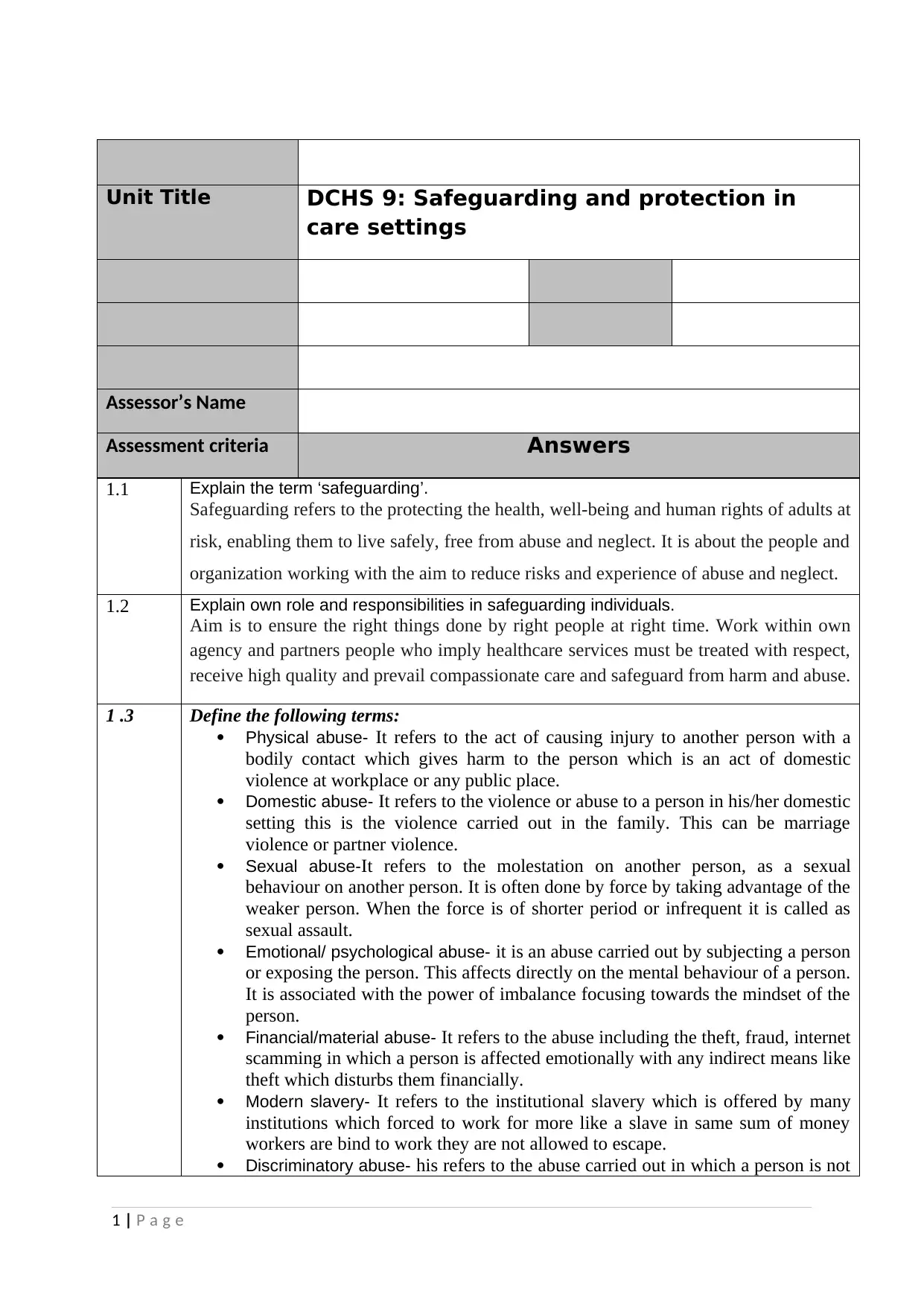
Unit Title DCHS 9: Safeguarding and protection in
care settings
Assessor’s Name
Assessment criteria Answers
1.1 Explain the term ‘safeguarding’.
Safeguarding refers to the protecting the health, well-being and human rights of adults at
risk, enabling them to live safely, free from abuse and neglect. It is about the people and
organization working with the aim to reduce risks and experience of abuse and neglect.
1.2 Explain own role and responsibilities in safeguarding individuals.
Aim is to ensure the right things done by right people at right time. Work within own
agency and partners people who imply healthcare services must be treated with respect,
receive high quality and prevail compassionate care and safeguard from harm and abuse.
1 .3 Define the following terms:
Physical abuse- It refers to the act of causing injury to another person with a
bodily contact which gives harm to the person which is an act of domestic
violence at workplace or any public place.
Domestic abuse- It refers to the violence or abuse to a person in his/her domestic
setting this is the violence carried out in the family. This can be marriage
violence or partner violence.
Sexual abuse-It refers to the molestation on another person, as a sexual
behaviour on another person. It is often done by force by taking advantage of the
weaker person. When the force is of shorter period or infrequent it is called as
sexual assault.
Emotional/ psychological abuse- it is an abuse carried out by subjecting a person
or exposing the person. This affects directly on the mental behaviour of a person.
It is associated with the power of imbalance focusing towards the mindset of the
person.
Financial/material abuse- It refers to the abuse including the theft, fraud, internet
scamming in which a person is affected emotionally with any indirect means like
theft which disturbs them financially.
Modern slavery- It refers to the institutional slavery which is offered by many
institutions which forced to work for more like a slave in same sum of money
workers are bind to work they are not allowed to escape.
Discriminatory abuse- his refers to the abuse carried out in which a person is not
1 | P a g e
care settings
Assessor’s Name
Assessment criteria Answers
1.1 Explain the term ‘safeguarding’.
Safeguarding refers to the protecting the health, well-being and human rights of adults at
risk, enabling them to live safely, free from abuse and neglect. It is about the people and
organization working with the aim to reduce risks and experience of abuse and neglect.
1.2 Explain own role and responsibilities in safeguarding individuals.
Aim is to ensure the right things done by right people at right time. Work within own
agency and partners people who imply healthcare services must be treated with respect,
receive high quality and prevail compassionate care and safeguard from harm and abuse.
1 .3 Define the following terms:
Physical abuse- It refers to the act of causing injury to another person with a
bodily contact which gives harm to the person which is an act of domestic
violence at workplace or any public place.
Domestic abuse- It refers to the violence or abuse to a person in his/her domestic
setting this is the violence carried out in the family. This can be marriage
violence or partner violence.
Sexual abuse-It refers to the molestation on another person, as a sexual
behaviour on another person. It is often done by force by taking advantage of the
weaker person. When the force is of shorter period or infrequent it is called as
sexual assault.
Emotional/ psychological abuse- it is an abuse carried out by subjecting a person
or exposing the person. This affects directly on the mental behaviour of a person.
It is associated with the power of imbalance focusing towards the mindset of the
person.
Financial/material abuse- It refers to the abuse including the theft, fraud, internet
scamming in which a person is affected emotionally with any indirect means like
theft which disturbs them financially.
Modern slavery- It refers to the institutional slavery which is offered by many
institutions which forced to work for more like a slave in same sum of money
workers are bind to work they are not allowed to escape.
Discriminatory abuse- his refers to the abuse carried out in which a person is not
1 | P a g e
Paraphrase This Document
Need a fresh take? Get an instant paraphrase of this document with our AI Paraphraser
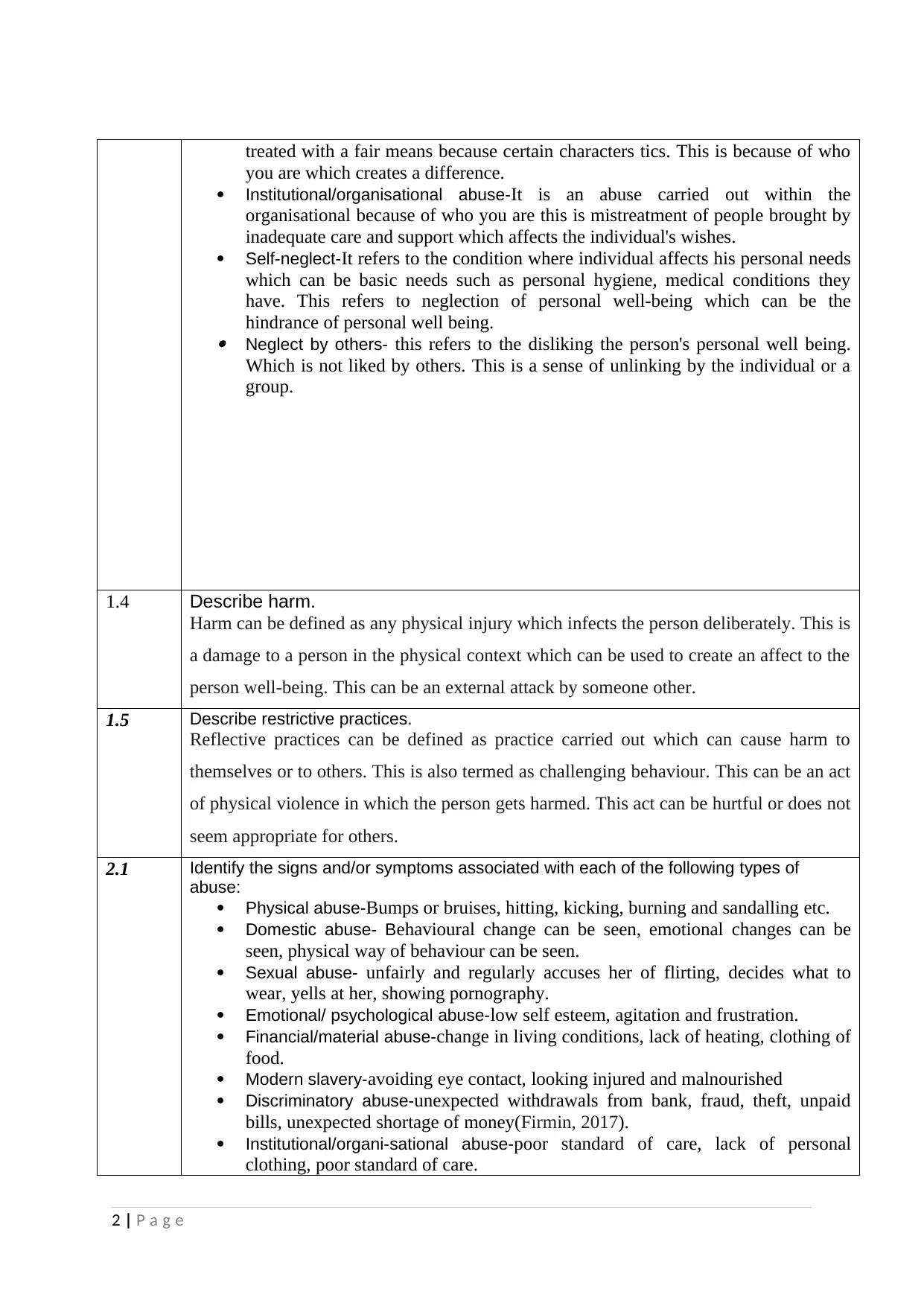
treated with a fair means because certain characters tics. This is because of who
you are which creates a difference.
Institutional/organisational abuse-It is an abuse carried out within the
organisational because of who you are this is mistreatment of people brought by
inadequate care and support which affects the individual's wishes.
Self-neglect-It refers to the condition where individual affects his personal needs
which can be basic needs such as personal hygiene, medical conditions they
have. This refers to neglection of personal well-being which can be the
hindrance of personal well being.
Neglect by others- this refers to the disliking the person's personal well being.
Which is not liked by others. This is a sense of unlinking by the individual or a
group.
1.4 Describe harm.
Harm can be defined as any physical injury which infects the person deliberately. This is
a damage to a person in the physical context which can be used to create an affect to the
person well-being. This can be an external attack by someone other.
1.5 Describe restrictive practices.
Reflective practices can be defined as practice carried out which can cause harm to
themselves or to others. This is also termed as challenging behaviour. This can be an act
of physical violence in which the person gets harmed. This act can be hurtful or does not
seem appropriate for others.
2.1 Identify the signs and/or symptoms associated with each of the following types of
abuse:
Physical abuse-Bumps or bruises, hitting, kicking, burning and sandalling etc.
Domestic abuse- Behavioural change can be seen, emotional changes can be
seen, physical way of behaviour can be seen.
Sexual abuse- unfairly and regularly accuses her of flirting, decides what to
wear, yells at her, showing pornography.
Emotional/ psychological abuse-low self esteem, agitation and frustration.
Financial/material abuse-change in living conditions, lack of heating, clothing of
food.
Modern slavery-avoiding eye contact, looking injured and malnourished
Discriminatory abuse-unexpected withdrawals from bank, fraud, theft, unpaid
bills, unexpected shortage of money(Firmin, 2017).
Institutional/organi-sational abuse-poor standard of care, lack of personal
clothing, poor standard of care.
2 | P a g e
you are which creates a difference.
Institutional/organisational abuse-It is an abuse carried out within the
organisational because of who you are this is mistreatment of people brought by
inadequate care and support which affects the individual's wishes.
Self-neglect-It refers to the condition where individual affects his personal needs
which can be basic needs such as personal hygiene, medical conditions they
have. This refers to neglection of personal well-being which can be the
hindrance of personal well being.
Neglect by others- this refers to the disliking the person's personal well being.
Which is not liked by others. This is a sense of unlinking by the individual or a
group.
1.4 Describe harm.
Harm can be defined as any physical injury which infects the person deliberately. This is
a damage to a person in the physical context which can be used to create an affect to the
person well-being. This can be an external attack by someone other.
1.5 Describe restrictive practices.
Reflective practices can be defined as practice carried out which can cause harm to
themselves or to others. This is also termed as challenging behaviour. This can be an act
of physical violence in which the person gets harmed. This act can be hurtful or does not
seem appropriate for others.
2.1 Identify the signs and/or symptoms associated with each of the following types of
abuse:
Physical abuse-Bumps or bruises, hitting, kicking, burning and sandalling etc.
Domestic abuse- Behavioural change can be seen, emotional changes can be
seen, physical way of behaviour can be seen.
Sexual abuse- unfairly and regularly accuses her of flirting, decides what to
wear, yells at her, showing pornography.
Emotional/ psychological abuse-low self esteem, agitation and frustration.
Financial/material abuse-change in living conditions, lack of heating, clothing of
food.
Modern slavery-avoiding eye contact, looking injured and malnourished
Discriminatory abuse-unexpected withdrawals from bank, fraud, theft, unpaid
bills, unexpected shortage of money(Firmin, 2017).
Institutional/organi-sational abuse-poor standard of care, lack of personal
clothing, poor standard of care.
2 | P a g e
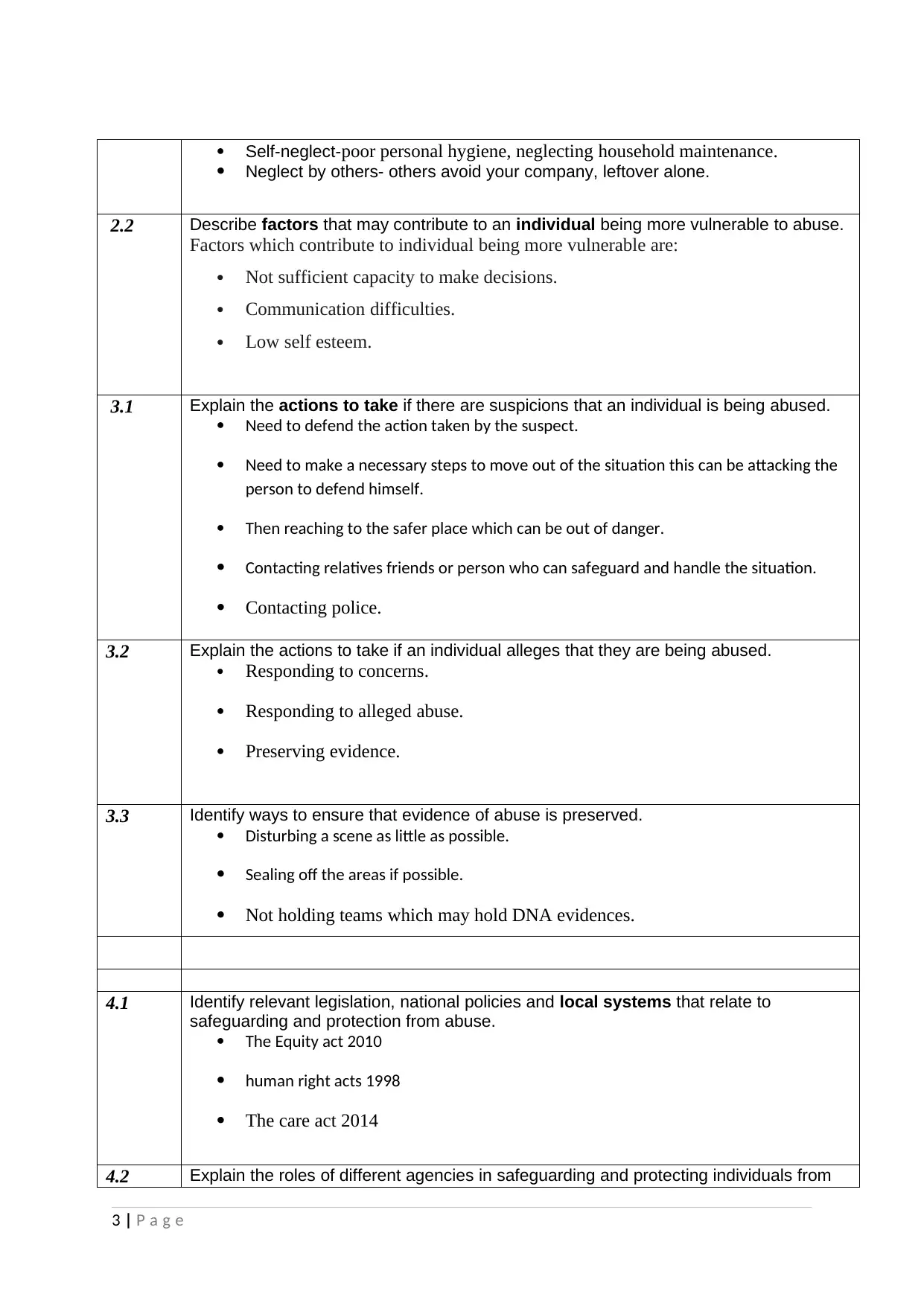
Self-neglect-poor personal hygiene, neglecting household maintenance.
Neglect by others- others avoid your company, leftover alone.
2.2 Describe factors that may contribute to an individual being more vulnerable to abuse.
Factors which contribute to individual being more vulnerable are:
Not sufficient capacity to make decisions.
Communication difficulties.
Low self esteem.
3.1 Explain the actions to take if there are suspicions that an individual is being abused.
Need to defend the action taken by the suspect.
Need to make a necessary steps to move out of the situation this can be attacking the
person to defend himself.
Then reaching to the safer place which can be out of danger.
Contacting relatives friends or person who can safeguard and handle the situation.
Contacting police.
3.2 Explain the actions to take if an individual alleges that they are being abused.
Responding to concerns.
Responding to alleged abuse.
Preserving evidence.
3.3 Identify ways to ensure that evidence of abuse is preserved.
Disturbing a scene as little as possible.
Sealing off the areas if possible.
Not holding teams which may hold DNA evidences.
4.1 Identify relevant legislation, national policies and local systems that relate to
safeguarding and protection from abuse.
The Equity act 2010
human right acts 1998
The care act 2014
4.2 Explain the roles of different agencies in safeguarding and protecting individuals from
3 | P a g e
Neglect by others- others avoid your company, leftover alone.
2.2 Describe factors that may contribute to an individual being more vulnerable to abuse.
Factors which contribute to individual being more vulnerable are:
Not sufficient capacity to make decisions.
Communication difficulties.
Low self esteem.
3.1 Explain the actions to take if there are suspicions that an individual is being abused.
Need to defend the action taken by the suspect.
Need to make a necessary steps to move out of the situation this can be attacking the
person to defend himself.
Then reaching to the safer place which can be out of danger.
Contacting relatives friends or person who can safeguard and handle the situation.
Contacting police.
3.2 Explain the actions to take if an individual alleges that they are being abused.
Responding to concerns.
Responding to alleged abuse.
Preserving evidence.
3.3 Identify ways to ensure that evidence of abuse is preserved.
Disturbing a scene as little as possible.
Sealing off the areas if possible.
Not holding teams which may hold DNA evidences.
4.1 Identify relevant legislation, national policies and local systems that relate to
safeguarding and protection from abuse.
The Equity act 2010
human right acts 1998
The care act 2014
4.2 Explain the roles of different agencies in safeguarding and protecting individuals from
3 | P a g e
⊘ This is a preview!⊘
Do you want full access?
Subscribe today to unlock all pages.

Trusted by 1+ million students worldwide
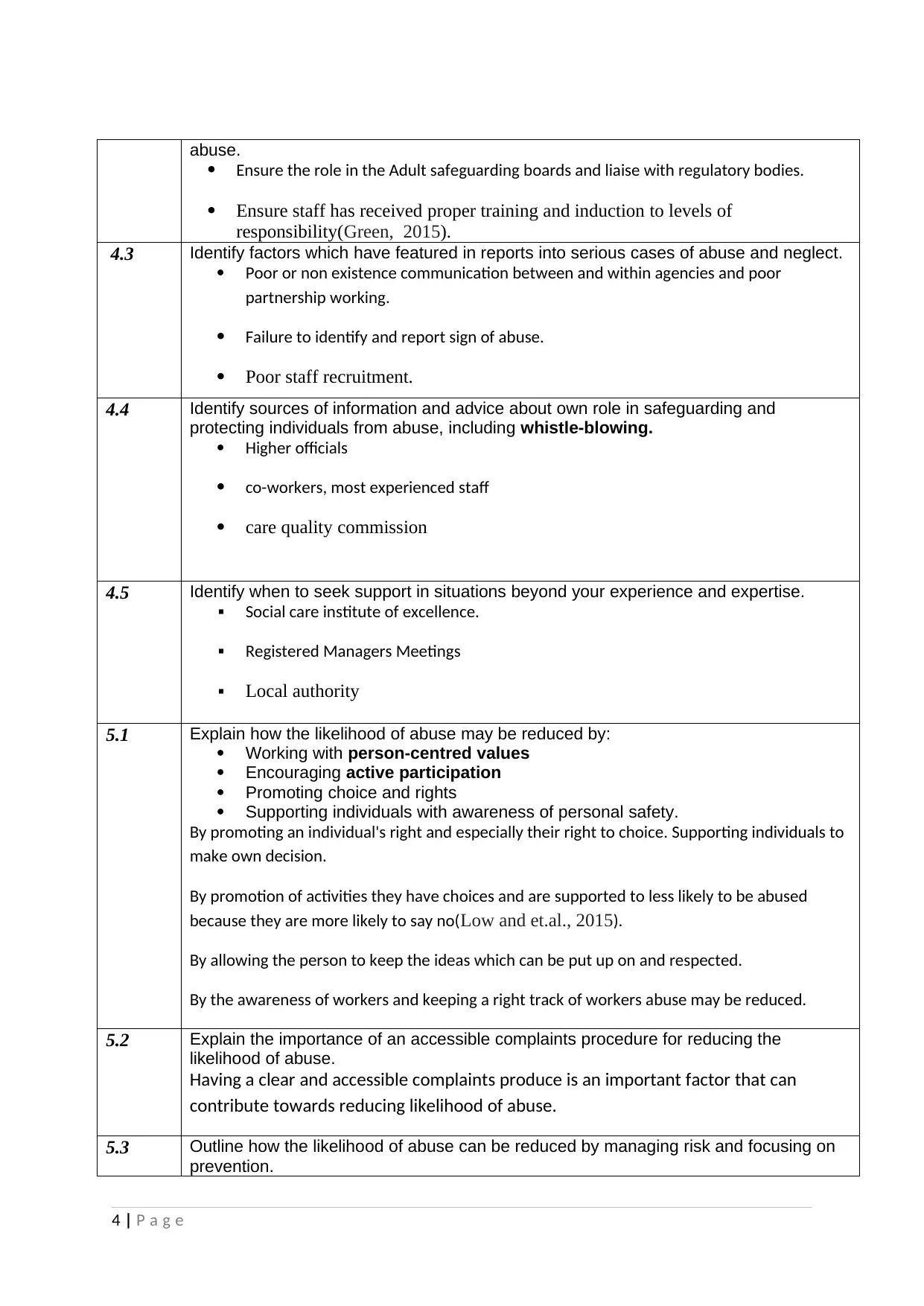
abuse.
Ensure the role in the Adult safeguarding boards and liaise with regulatory bodies.
Ensure staff has received proper training and induction to levels of
responsibility(Green, 2015).
4.3 Identify factors which have featured in reports into serious cases of abuse and neglect.
Poor or non existence communication between and within agencies and poor
partnership working.
Failure to identify and report sign of abuse.
Poor staff recruitment.
4.4 Identify sources of information and advice about own role in safeguarding and
protecting individuals from abuse, including whistle-blowing.
Higher officials
co-workers, most experienced staff
care quality commission
4.5 Identify when to seek support in situations beyond your experience and expertise.
Social care institute of excellence.
Registered Managers Meetings
Local authority
5.1 Explain how the likelihood of abuse may be reduced by:
Working with person-centred values
Encouraging active participation
Promoting choice and rights
Supporting individuals with awareness of personal safety.
By promoting an individual's right and especially their right to choice. Supporting individuals to
make own decision.
By promotion of activities they have choices and are supported to less likely to be abused
because they are more likely to say no(Low and et.al., 2015).
By allowing the person to keep the ideas which can be put up on and respected.
By the awareness of workers and keeping a right track of workers abuse may be reduced.
5.2 Explain the importance of an accessible complaints procedure for reducing the
likelihood of abuse.
Having a clear and accessible complaints produce is an important factor that can
contribute towards reducing likelihood of abuse.
5.3 Outline how the likelihood of abuse can be reduced by managing risk and focusing on
prevention.
4 | P a g e
Ensure the role in the Adult safeguarding boards and liaise with regulatory bodies.
Ensure staff has received proper training and induction to levels of
responsibility(Green, 2015).
4.3 Identify factors which have featured in reports into serious cases of abuse and neglect.
Poor or non existence communication between and within agencies and poor
partnership working.
Failure to identify and report sign of abuse.
Poor staff recruitment.
4.4 Identify sources of information and advice about own role in safeguarding and
protecting individuals from abuse, including whistle-blowing.
Higher officials
co-workers, most experienced staff
care quality commission
4.5 Identify when to seek support in situations beyond your experience and expertise.
Social care institute of excellence.
Registered Managers Meetings
Local authority
5.1 Explain how the likelihood of abuse may be reduced by:
Working with person-centred values
Encouraging active participation
Promoting choice and rights
Supporting individuals with awareness of personal safety.
By promoting an individual's right and especially their right to choice. Supporting individuals to
make own decision.
By promotion of activities they have choices and are supported to less likely to be abused
because they are more likely to say no(Low and et.al., 2015).
By allowing the person to keep the ideas which can be put up on and respected.
By the awareness of workers and keeping a right track of workers abuse may be reduced.
5.2 Explain the importance of an accessible complaints procedure for reducing the
likelihood of abuse.
Having a clear and accessible complaints produce is an important factor that can
contribute towards reducing likelihood of abuse.
5.3 Outline how the likelihood of abuse can be reduced by managing risk and focusing on
prevention.
4 | P a g e
Paraphrase This Document
Need a fresh take? Get an instant paraphrase of this document with our AI Paraphraser
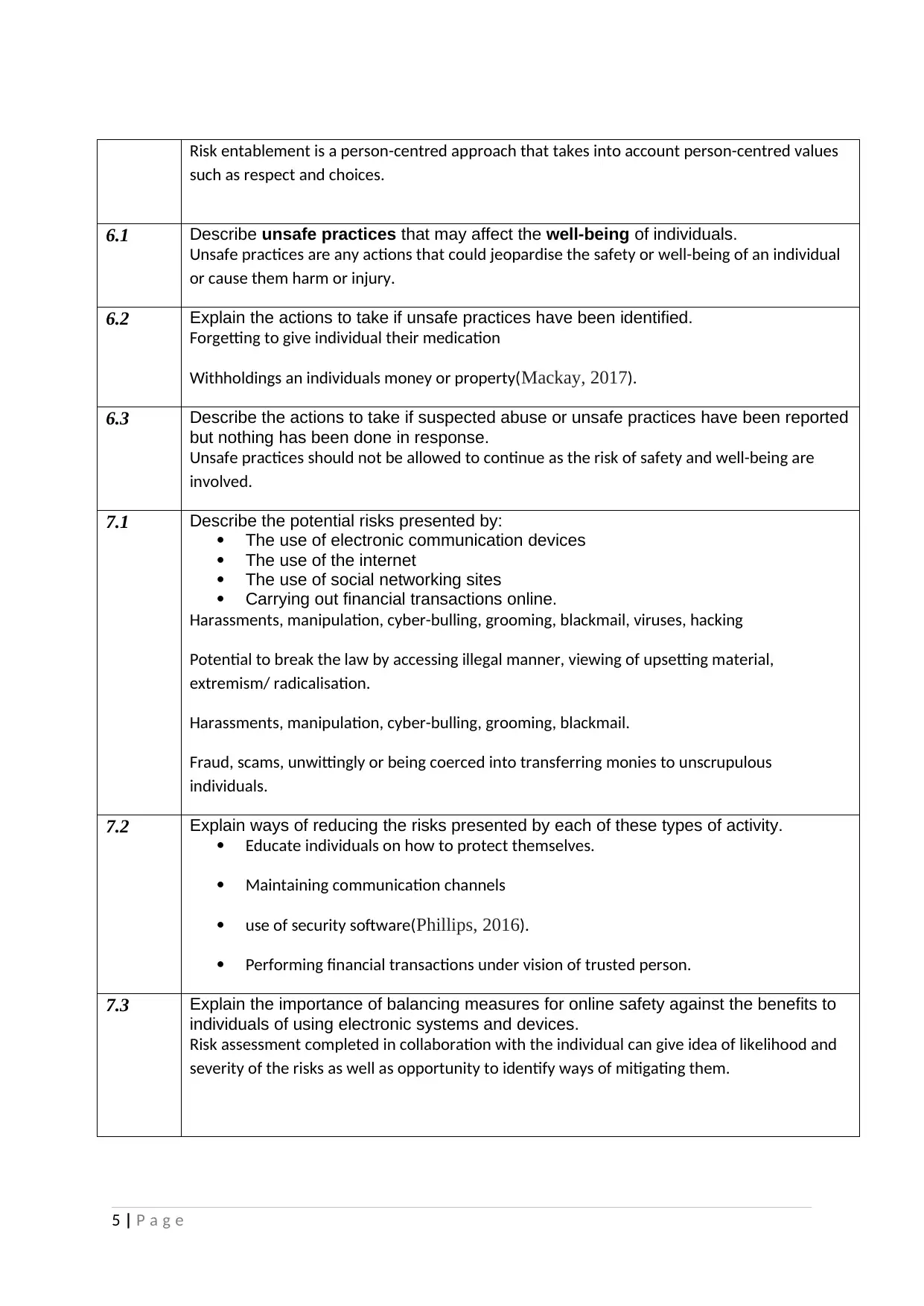
Risk entablement is a person-centred approach that takes into account person-centred values
such as respect and choices.
6.1 Describe unsafe practices that may affect the well-being of individuals.
Unsafe practices are any actions that could jeopardise the safety or well-being of an individual
or cause them harm or injury.
6.2 Explain the actions to take if unsafe practices have been identified.
Forgetting to give individual their medication
Withholdings an individuals money or property(Mackay, 2017).
6.3 Describe the actions to take if suspected abuse or unsafe practices have been reported
but nothing has been done in response.
Unsafe practices should not be allowed to continue as the risk of safety and well-being are
involved.
7.1 Describe the potential risks presented by:
The use of electronic communication devices
The use of the internet
The use of social networking sites
Carrying out financial transactions online.
Harassments, manipulation, cyber-bulling, grooming, blackmail, viruses, hacking
Potential to break the law by accessing illegal manner, viewing of upsetting material,
extremism/ radicalisation.
Harassments, manipulation, cyber-bulling, grooming, blackmail.
Fraud, scams, unwittingly or being coerced into transferring monies to unscrupulous
individuals.
7.2 Explain ways of reducing the risks presented by each of these types of activity.
Educate individuals on how to protect themselves.
Maintaining communication channels
use of security software(Phillips, 2016).
Performing financial transactions under vision of trusted person.
7.3 Explain the importance of balancing measures for online safety against the benefits to
individuals of using electronic systems and devices.
Risk assessment completed in collaboration with the individual can give idea of likelihood and
severity of the risks as well as opportunity to identify ways of mitigating them.
5 | P a g e
such as respect and choices.
6.1 Describe unsafe practices that may affect the well-being of individuals.
Unsafe practices are any actions that could jeopardise the safety or well-being of an individual
or cause them harm or injury.
6.2 Explain the actions to take if unsafe practices have been identified.
Forgetting to give individual their medication
Withholdings an individuals money or property(Mackay, 2017).
6.3 Describe the actions to take if suspected abuse or unsafe practices have been reported
but nothing has been done in response.
Unsafe practices should not be allowed to continue as the risk of safety and well-being are
involved.
7.1 Describe the potential risks presented by:
The use of electronic communication devices
The use of the internet
The use of social networking sites
Carrying out financial transactions online.
Harassments, manipulation, cyber-bulling, grooming, blackmail, viruses, hacking
Potential to break the law by accessing illegal manner, viewing of upsetting material,
extremism/ radicalisation.
Harassments, manipulation, cyber-bulling, grooming, blackmail.
Fraud, scams, unwittingly or being coerced into transferring monies to unscrupulous
individuals.
7.2 Explain ways of reducing the risks presented by each of these types of activity.
Educate individuals on how to protect themselves.
Maintaining communication channels
use of security software(Phillips, 2016).
Performing financial transactions under vision of trusted person.
7.3 Explain the importance of balancing measures for online safety against the benefits to
individuals of using electronic systems and devices.
Risk assessment completed in collaboration with the individual can give idea of likelihood and
severity of the risks as well as opportunity to identify ways of mitigating them.
5 | P a g e
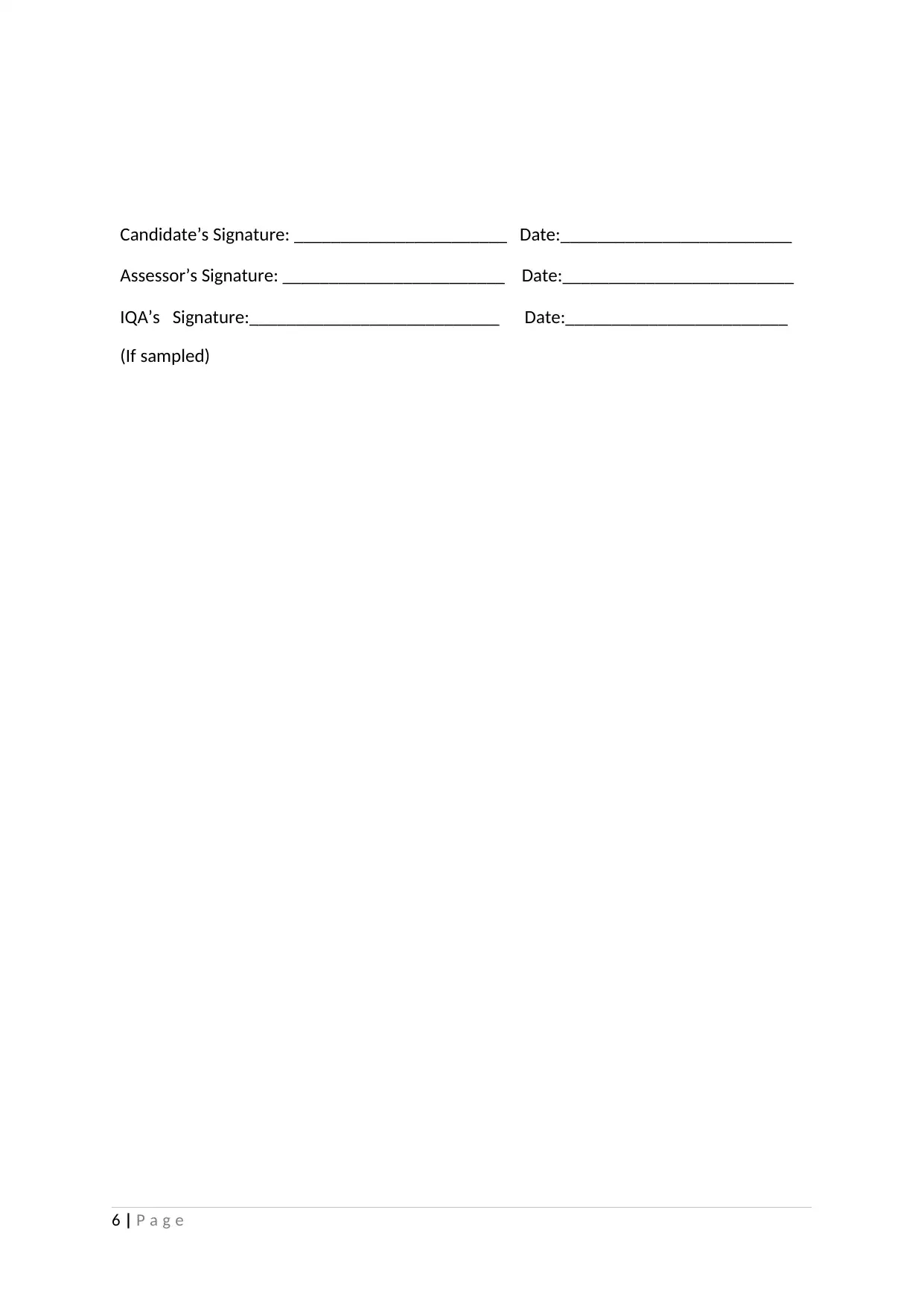
Candidate’s Signature: _______________________ Date:_________________________
Assessor’s Signature: ________________________ Date:_________________________
IQA’s Signature:___________________________ Date:________________________
(If sampled)
6 | P a g e
Assessor’s Signature: ________________________ Date:_________________________
IQA’s Signature:___________________________ Date:________________________
(If sampled)
6 | P a g e
⊘ This is a preview!⊘
Do you want full access?
Subscribe today to unlock all pages.

Trusted by 1+ million students worldwide
1 out of 6
Related Documents
Your All-in-One AI-Powered Toolkit for Academic Success.
+13062052269
info@desklib.com
Available 24*7 on WhatsApp / Email
![[object Object]](/_next/static/media/star-bottom.7253800d.svg)
Unlock your academic potential
Copyright © 2020–2025 A2Z Services. All Rights Reserved. Developed and managed by ZUCOL.





